Next-gen Ford Focus – Click above for high-res image gallery
As we begin 2010, it looks like the compact C-segment is shaping up to be one of the most highly competitve segments in the auto industry. The Honda Civic, Toyota Corolla, VW Golf and Jetta, along with the new Chevrolet Cruze are fighting for the hearts, minds and dollars of the masses. And then there's the Ford Focus.
This week in Detroit, Ford is unwrapping an all-new Focus for the 2012 model year. When the original Focus debuted internationally in 1998 and then in the U.S. a year later, it was more or less a common design. The U.S. version, however, suffered from a series of manufacturing issues and recalls within its first year of sales. Meanwhile, the overseas model got a full redesign in 2004, but Americans kept the MK1 Focus until three years ago when it got an unfortunately awkward re-skin. This time around the new Focus is truly global and adopts the latest evolution of Ford's European "Kinetic" design language. Judging by our first exposure to the 2012 Focus, every other contender in the segment may have a real problem to deal with next year. Learn more about the new Focus after the jump.
The new 2010 Focus sedan and five-door hatchback represent the third and fourth body styles of the new global C-platform from Ford. The European C-Max and Grand C-Max debuted last September at the Geneva Motor Show with the latter scheduled to land in the U.S. next year. Over the next year or so we will be seeing six more "top-hats" on the C-platform, including a station wagon, three-door hatch and hard-top coupe-convertible, some of which will be sold here in North America while others will only be available overseas.
With these new body styles being added and general growth in the segment, Ford hopes to double its current market penetration and sell about two million C-segment vehicles worldwide by 2012. In 2009 alone, one in four cars sold globally will be C-segment, a share that is expected to increase.
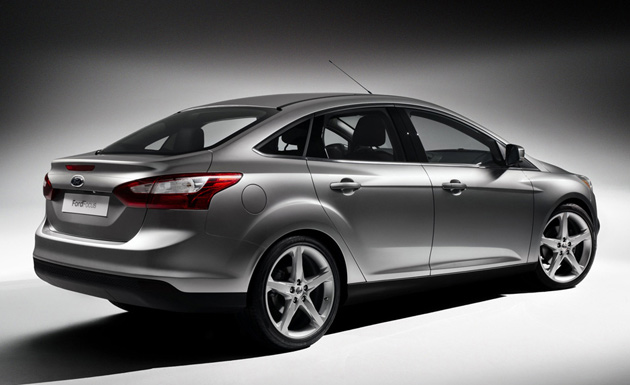
In discussing where Ford was going with the new Focus, company reps explained that the company's development philosophy is "Great to look at, Great to sit in, Great to drive," and this applied to the Focus just as much as it does to a Mustang. In recent years, customers have "downsized in terms of vehicle size, but not in expectations." That means customers don't want to give up any features and amenities that they've come to expect in an SUV when buying a compact car.
If Ford (and Chevrolet) can succeed in following brands like MINI in convincing Americans to pay more for well-equipped and attractive small cars, it will go a long way toward bringing this market in line with the rest of the world. Judging by our first look at the new Focus, Ford may be well on its way to a very strong position in the small-car segment in the U.S.
The 2011 Focus could be described as the first, second-generation Kinetic design from Ford, as the look has evolved a bit from the most recent batch of European Fords. Among the hallmarks of Kinetic design have been a large trapezoidal lower grille, bold wheel arches and a prominent character line running from the front wheel back to the rear quarter.
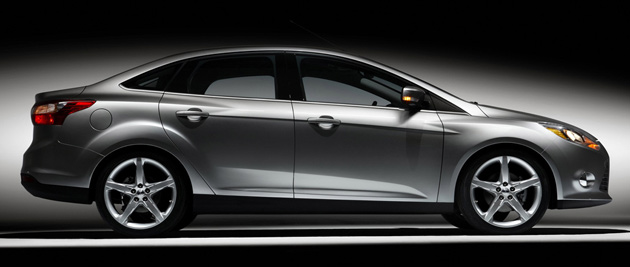
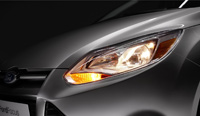
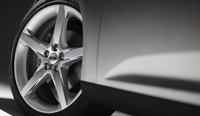
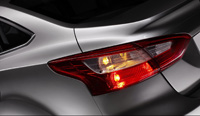
On the new Focus, longitudinal creases in the hood extend down between the upper grille into the trapezoid dividing it into three sections. The wheel arch creases now extend straight back from the top of the arch above the main lateral crease blending out a few inches behind the start of the lower line. A similar crease is echoed on the rear quarter with the overlap area at each end forming a "Z" that Ford refers to as a "Zorro flip." The rear quarter character line also forms a prominent rear shoulder area. Around the back, large tail-lamp clusters finish off the bold styling. Some might consider the styling a bit too bold or over-done, but it works quite well in person and certainly makes the new Focus stand out in this crowded segment.
This is hardly Ford's first attempt at a global design. The early '80s Escort, the first-generation Focus and the Mondeo/Contour were all attempts at "world cars" that went awry. Ford addressed the question of such world cars having failed in the past and why it might work now. First of all, each of those previous attempts ended up diverging because of different regional demands and tastes. However, Ford says that global tastes are converging in terms of design and vehicle requirements in this Internet age.
When the U.S. Focus was refreshed a couple of years ago, management opted to discontinue the previous three- and five-door hatchbacks in favor or a two-door coupe to accompany the sedan. In the intervening years, it's become increasingly clear that hatchbacks do have some appeal in this market if they're made desirable enough. As a result, the next-gen Focus, which likely will be labeled a 2011 model, will be offered to Americans as a four-door sedan and five-door hatchback just like the new Fiesta. The sedan also will get a swept roof-line and tall rear deck profile like the Fiesta sedan.
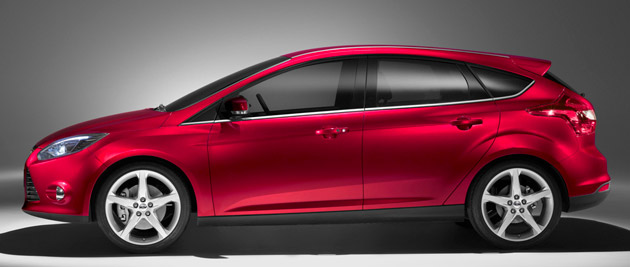
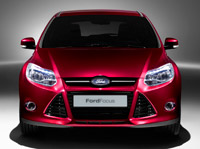
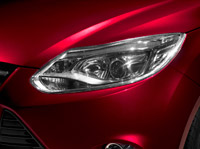
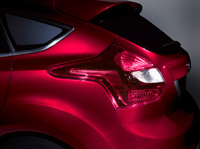
The new sedan is dimensionally about one inch lower than the outgoing Focus sedan but a little less than an inch wider than the current European model. The overall length and weight are claimed to be about the same, as is the interior volume. Speaking of the interior, the sedan that we previewed had an interior that takes compact cars to a whole new level. The car we were shown was a Titanium trim level, which is new to the U.S. market but has been offered in Europe for several years already.
After Ford started offering the Titanium trim in Europe, it was surprised at the popularity of such a premium finish in this class of car. As many as 40 percent of European buyers have opted for the Titanium trim level, and on the Mondeo it's up to 60 percent. The inside of the new Focus looks like something you would expect to find in an Audi or Lexus more than the direct descendant of the Escort. Will Americans be willing to pay prices up to the low $20,000-range for a Focus? We'll find out soon enough. At this point, we don't know what the base level trim will look like, but if the Fiesta is anything to go by, it should still be much nicer than any current Focus.
After being the debut vehicle for SYNC three years ago, the Focus will be one of the first Ford models offered with the optional MyFord Touch control system that debuts this summer in the new Lincoln MKX. In addition, drivers who opt for navigation will get a new eight-inch screen – by far the largest we've ever encountered in a small car.
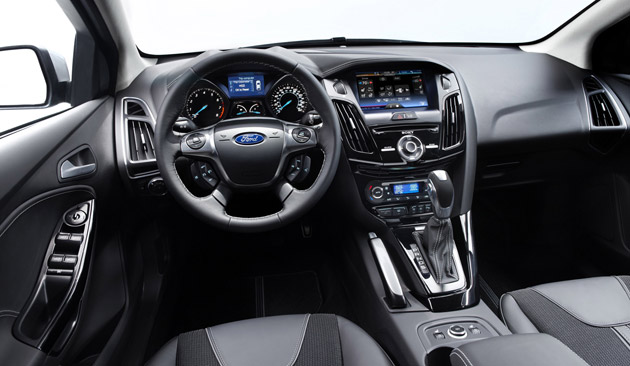
When the first-generation Focus appeared a decade ago, it was praised for its driving dynamics and the current Euro model is considered among the best of its breed. The 300-hp Focus RS has been renowned as one of the most un-front-wheel-drive-like front-wheel-drive cars ever. While there are currently no plans for an RS model here in the U.S., North American Focus chief engineer Jim Hughes does promise that nothing will be lost in translation when this Focus hits U.S. roads.
Like other new Fords, the next-gen Focus also is getting an electric power assist system (EPAS) for its steering, which helps to reduce fuel consumption by cutting parasitic losses. Hughes claims the Focus dynamics team has improved the steering precision and feel with this EPAS system, something we'll have to judge for ourselves later in the year when we get a chance to drive it. Until now, EPAS has tended to be a mixed bag, with some applications like the Honda Fit having excellent feel while others have no feedback. Ford applications have generally done pretty well on this count, so we are hopeful.
One more interesting feature that will be available on the next-gen Focus is Dynamic Cornering Control. While torque vectoring has been increasingly used in high performance all-wheel-drive systems from Acura, BMW and Audi, Ford is applying the concept to the front-wheel-drive Focus. If it delivers, this should help provide even better handling balance with less understeer in the new compact.
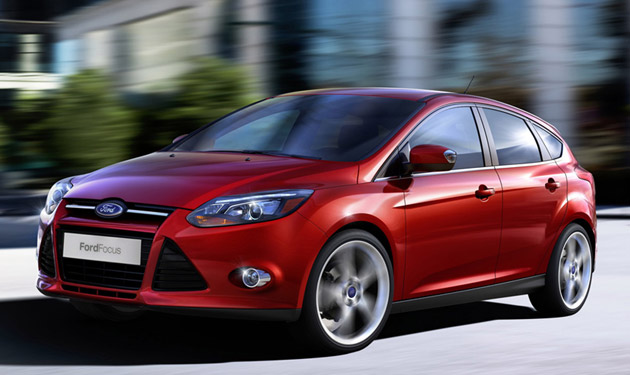
American Focus buyers will get one brand new engine and two transmission options at launch early next year. Like other new Fords, six-speed gearboxes are now the norm for Focus with a choice of manual or dual-clutch PowerShift units available. No traditional torque converter automatic will be offered in the Focus, but the PowerShift will get manual shift capability unlike the Fiesta. Unfortunately, the manual control comes by way of a switch on the side of the shift knob – no wheel-mounted shift paddles.
The engine is a new 2.0-liter direct-injected four-cylinder, which will also form the basis of the upcoming 2.0-liter EcoBoost. The normally aspirated unit will be rated at an estimated 155 hp and 145 pound-feet. Both cams are equipped with variable phasing using the same cam-torque actuation system as the Fusion's 2.5-liter and the new 5.0-liter V8 in the Mustang. Thanks to the charge cooling effect of direct injection, the new engine will have a 12:1 compression ratio, which should aid low end torque production. The new engine will also be E85 flex-fuel capable, a first for a DI engine. No one from Ford would confirm the availability of an EcoBoost engine in the Focus, but they did hint that the 1.6-liter GTDI would eventually be an option. Another feature that will be new to the Focus is automatic start-stop functionality that switches off the engine when the car comes to a halt. This will be one of the first such applications in the U.S. market in a non-hybrid vehicle.
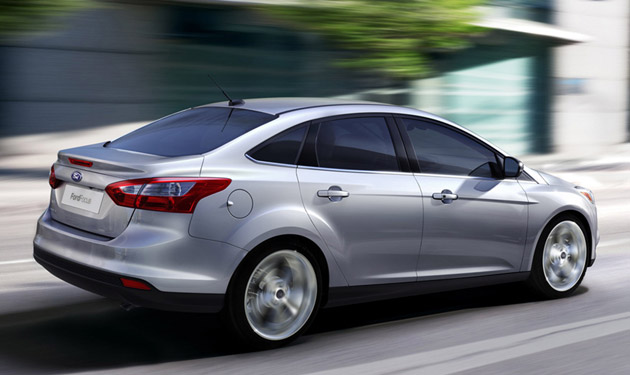
The other powertrain that we'll definitely see in the Focus is a full battery electric option. The Focus Electric will join the lineup sometime in 2011 using a lithium ion battery pack and electric drive developed in cooperation with Magna International. The Focus Electric is expected to have a driving range of 80-100 miles.
Ford isn't talking mileage numbers for the next-gen Focus yet, but it clearly is a priority for the new car. With Chevrolet aiming for 40+ mpg on the highway for the the Cruze, Ford will surely be trying to match it. To that end, designers have also focused a lot on functional aerodynamics in addition to just aesthetic styling. One of the more interesting features are thermostatically controlled shutters behind the grille. At higher speeds when more air naturally flows through the radiator, the shutters automatically close and force air around the sides of the car.
The new Focus body has also been designed to meet crash safety standards globally with a common structure. In order to meet those divergent requirements without adding excessive weight, the structure is comprised of 55 percent high strength steels. The B-pillar is produced by a process known as tailored rolling that makes eight different gauge thicknesses across its length. This allows strength to be put where its needed while keeping mass to a minimum. As with all new cars, there is a plethora of air bags that can inflate from all directions, and new inflators allow them to deploy 30 percent faster than in the current Focus.
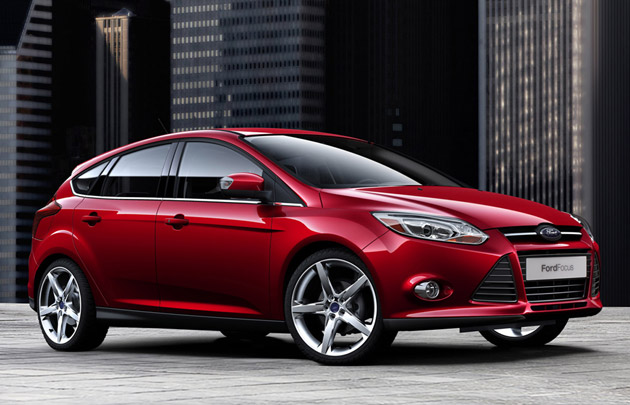
One of the reasons that the first-gen Focus encountered so many quality problems was untested production processes. Focuses built in Europe and North America were produced on completely different machinery with completely different processes, and Euro models never had the issues that occurred here. Going forward, the One Forward policy applies across the board including design and manufacturing. Focuses built in France, Spain, China and Michigan will all use the same equipment, work instructions and production steps.
Production of the Focus will start almost simultaneously in Wayne, Michigan and Saarlouis, France late in 2010, with additional production starting over the next two years in Russia and China. The media preview we attended a few weeks ago was held at the newly renamed Michigan Assembly Plant (MAP). Until early 2009, the plant was known as Michigan Truck Plant and housed Navigator and Expedition production. MAP is one of three truck plants that are being converted to car production and Ford is making a big bet that this is the right way to go. It will no doubt help the Blue Oval meet its upcoming CAFE obligations. Now it just has to convince consumers to buy all these cars its building. Things look promising so far with the Fusion breaking sales records, the Fiesta building buzz and now this, the next-gen Focus, which should take the fight straight to cars like the Cruze, Civic and Corolla.
DYNAMIC NEXT-GENERATION FORD FOCUS DEBUTS
• Next-generation Ford Focus makes its worldwide debut at 2010 North American International Auto Show (NAIAS) in Detroit
• Focus spearheads Ford's new generation of global C-cars, all based on a common platform that will underpin up to 10 vehicles around the world and account for 2 million units of annual production by 2012
• Stylish new range provides customers with class-leading new technologies, features and craftsmanship
• New Focus targets exceptional fuel economy, and advances acclaimed levels of driving quality
• New range will start production simultaneously in Europe and North America in late 2010 and go on sale early in 2011. Asia, Africa and South America production will follow
DETROIT, Jan. 11, 2010 – The next-generation Ford Focus makes its worldwide debut providing customers with more affordable technologies and features than ever in this segment, as well as detailed craftsmanship, outstanding fuel economy and a new standard for driving quality.
Sleek, stylish and sporty, both the four-door sedan and five-door hatchback body styles of the next-generation Focus are previewed prior to their production start for Europe and North America late in 2010 and market launch early in 2011.
The new Focus will be nearly identical in all markets, with 80 percent parts commonality around the world.
"The new Ford Focus is a clear demonstration that our ONE Ford strategy is providing global consumers with great products that harness the best of Ford Motor Company," said Alan Mulally, Ford's president and CEO.
"The efficiencies generated by our new global C-car platform will enable us to provide Ford Focus customers with an affordable product offering quality, fuel efficiency, safety and technology beyond their expectations," he added.
Simultaneous launch in Europe and North America
Production of the next-generation Ford Focus will begin simultaneously in Europe and North America in late 2010, with individual market launches starting early in 2011. Launches in Asia, Africa and South America will follow. Initial production will be concentrated at the Saarlouis (Germany), Michigan (United States) and Chongqing (China) Assembly Plants.
The new Focus will be one of up to 10 unique models to be built from Ford's new C-car platform, which is expected to generate total sales in all regions of 2 million units annually by 2012. The first of these will be the new Ford C-MAX and Ford Grand C-MAX – unveiled at the 2009 Frankfurt Motor Show – for launch in Europe in the second half of 2010.
"Global customers increasingly want smaller cars with outstanding fuel economy, but without sacrificing any of the style, technology, connectivity and driving quality they demand from larger vehicles," explained Derrick Kuzak, Ford's group vice president of Global Product Development.
"Our next generation of C-cars – led by the exciting new Focus – will clearly show that Ford is ready to meet that challenge," said Kuzak.
Engineered without compromise
The new Ford Focus has been developed by a global team, led from Ford's European small and medium vehicle center of excellence in Merkenich, near Cologne, Germany, with powertrain development led by a similar team at Ford's technical center in Dunton, England. The vehicle has been engineered without compromise to meet all customer and legislative requirements of the major worldwide markets.
In developing the vehicle for global markets, the product team in Europe was able to call on the experience acquired from recent programs like the much-acclaimed new Ford Fiesta, and was supported by the expertise of vehicle and powertrain technology specialists located in Ford's engineering center in Dearborn, Mich.
Ford's global development and sourcing strategy made it possible to provide a level of performance and feature content that is unrivaled for this vehicle segment and surprising even to drivers of larger, more premium vehicles.
Taking kinetic design to the next level
The no-compromise approach to the new Ford Focus is immediately evident from the striking exterior design of the four-door sedan and five-door hatchback models that take center stage at the 2010 NAIAS.
"The all-new Focus is at the center of convergence for automotive trends," said J Mays, Ford group vice president of Design and chief creative officer. "We've designed it with an acute understanding of global customers, yet it's tailored for each individual region. Focus combines the best from Europe, North America and Asia to deliver a level of emotional driving enjoyment never before experienced in a car this size."
The two models share a sporty and dynamic character, marking the next evolution of Ford's acclaimed kinetic design form language, which has contributed to the growing popularity of the company's latest small and medium cars.
The kinetic design approach uses bold vehicle designs to capture the feeling of energy in motion, so that cars look like they are moving – even when they are standing still.
With its striking front end, sleek profile, dramatic rising beltline and athletic stance, the new Focus clearly telegraphs the rewarding driving experience that awaits customers when they take to the road.
This dynamic quality is reinforced by the distinctive design of the interior. The new Focus has an extremely modern, cockpit-style interior, with the stylish center console wrapped around the driver and providing outstanding access to the vehicle's major controls and display panels.
A key element of the interior is the quality of craftsmanship. The cabin's bold and contemporary graphics, the sculptured shape of the soft-touch instrument panel and the choice of superior trim materials all help to give occupants the feeling that they are traveling in a premium-class car.
Unmatched driving quality
When it was introduced in 1998, the original Ford Focus brought new levels of agility and responsiveness to the C-segment. The all-new Focus plans to raise the benchmark once more, targeting class-leading driving quality that blends outstanding steering precision and road feedback with significantly improved refinement and ride control.
To deliver this performance, engineers have updated the innovative suspension concepts from prior models, developing optimized new designs for the "control blade" multilink rear suspension and the semi-isolated front and rear subframes.
The chassis design is complemented by a completely new Electric Power Assist Steering system, which has been carefully tuned to deliver pure and precise responses at high speed while remaining light and maneuverable for parking.
Ford's European driving dynamics specialists have also enhanced cornering stability and agility with the introduction of an advanced Dynamic Cornering Control system, which uses "torque vectoring" techniques to transfer power between the drive wheels to deliver reduced understeer, improved traction and better turn-in.
All global customers will benefit from the same quality of dynamic performance in the new Focus. Identical chassis and suspension architecture is being used for all markets, except for minor regional tuning differences, such as local tire specifications.
Efficient powertrains deliver performance with outstanding economy
The engaging driver appeal of the new Ford Focus is magnified by a powertrain range that delivers spirited performance and targets outstanding levels of fuel economy and CO2 emissions.
The global powertrain lineup for the new Focus will include a range of state-of-the-art Ford EcoBoost™ four-cylinder turbocharged direct injection (DI) engines – including the 1.6-liter unit in Europe and a choice of advanced and improved Duratorq TDCi common-rail diesel engines, all of which offer reductions in fuel consumption of between 10 and 20 percent compared to the outgoing models.
For the NAIAS preview, Ford is showing a completely new 2.0-liter gasoline engine for the North American market that features DI and Twin Independent Variable Camshaft Timing (Ti-VCT) for enhanced performance and fuel efficiency. The new 2.0-liter DI Ti-VCT engine is up to 20 horsepower more powerful than the current 2.0 Duratec I-4 unit while contributing to projected fuel economy gains of more than 10 percent.
To maximize the performance and economy advantage enjoyed by the new Focus, the 2.0-liter DI Ti-VCT engine is mated with the latest dry-clutch six-speed Ford PowerShift automatic transmission. This transmission uses an advanced dual-clutch design, which alone can help to reduce fuel consumption by up to 9 percent compared to a traditional four-speed automatic.
The dry-clutch PowerShift transmission is based on more efficient manual gearbox technology, and does not require the additional weight and complexity of torque converters, planetary gears and oil pumps used in conventional automatics. Electronically controlled twin clutches shift gears quickly and smoothly, providing the seamless flow of torque plus the refinement and ease of operation customers expect from a premium automatic transmission.
Ford also has confirmed plans to begin building a full, battery electric vehicle in 2011 at its Michigan Assembly Complex, for sales in North America. It will be the company's first battery electric passenger vehicle.
Intuitive technology enhances convenience and safety
The next-generation Focus will bring C-segment customers around the world an exciting array of advanced technologies generally found in larger, more premium vehicles. The global scale of Ford's C-car program makes more technologies and features economically viable than ever before for cars in this segment.
The technology package of the new Focus promises not only clear leadership in the C-segment, but also includes features customers in larger, more premium segments would find surprising.
The new technologies have been designed to be simple and highly intuitive to use, while enhancing both convenience and safety for the vehicle occupants.
Within the cockpit, the most significant innovation is the company's next-generation driver connect technology, MyFord, which provides the driver with a state-of-the-art combination of controls and display screens to operate the key vehicle features. On high series vehicles, the MyFord system includes an 8-inch touch screen, allowing the driver to control a wide range of functions via a clear and intuitive color display.
MyFord is complemented by a new generation of Ford's powerful SYNC® connectivity package, which includes a sophisticated voice control system, Bluetooth and satellite navigation, along with connection points for a wide variety of external devices and media players.
Other available safety and convenience technologies include keyless entry and "Ford Power" start button, a rearview camera and a semi-automatic parallel parking system that automatically steers the vehicle into a parking spot.
Strength and safety
The Focus platform provides an incredibly strong and stiff structure, which not only benefits vehicle dynamics and refinement but also provides the basis for enhanced crash performance.
High-strength steels are used extensively in the next-generation Focus body shell. High-strength steels comprise 55 percent of the body shell, and more than 26 percent of the vehicle's structure is formed from ultra-high-strength and Boron steels – significantly more than any other Ford product. These advanced materials help the structure meet the most stringent crash legislation across world markets, while minimizing the vehicle's weight.
The structural integrity of the body shell is also reflected in its torsional rigidity, which is 25 percent greater than the current North American Focus.
Quality and craftsmanship in every detail
With global customers now demanding a more premium experience from small- and medium-sized vehicles, achieving outstanding levels of quality and craftsmanship was a primary objective for the new Focus.
The new Focus will make significant strides in reducing cabin noise, promising a quiet cabin environment. This refinement complements the fresh new interior design and higher craftsmanship levels to create a premium feel akin to larger vehicles.
Each component in the vehicle that the customer will touch, see, hear or even smell has been subjected to rigorous analysis to ensure that it will exceed an owner's expectations. Particular attention has been given to the quality of interior trim materials, and the color matching, gaps, flushness and tolerances where one part meets another.
Across the majority of vehicle attributes, Ford has developed a global DNA standard that defines the exact attributes a part should have to meet the quality requirements of the brand. Examples include the sound the door makes when it is closed, requiring special attention to the door structure and latch mechanism, and the design of a steering wheel, right down to the thickness of padding and size of stitching on the rim.
This meticulous attention to detail is also reflected in Ford's global manufacturing strategy for the Focus, with consistent standards and processes being applied in every one of the assembly plants, wherever they are located in the world.
"We believe the new Ford Focus will provide consumers with an unmatched driving experience, together with an unrivaled ownership experience," said Jim Farley, Ford group vice president, Global Marketing. "The Focus brand always has been very special to Ford, and this new global model shows our commitment to developing another generation of exciting and appealing cars."
• Next-generation Ford Focus makes its worldwide debut at 2010 North American International Auto Show (NAIAS) in Detroit
• Focus spearheads Ford's new generation of global C-cars, all based on a common platform that will underpin up to 10 vehicles around the world and account for 2 million units of annual production by 2012
• Stylish new range provides customers with class-leading new technologies, features and craftsmanship
• New Focus targets exceptional fuel economy, and advances acclaimed levels of driving quality
• New range will start production simultaneously in Europe and North America in late 2010 and go on sale early in 2011. Asia, Africa and South America production will follow
DETROIT, Jan. 11, 2010 – The next-generation Ford Focus makes its worldwide debut providing customers with more affordable technologies and features than ever in this segment, as well as detailed craftsmanship, outstanding fuel economy and a new standard for driving quality.
Sleek, stylish and sporty, both the four-door sedan and five-door hatchback body styles of the next-generation Focus are previewed prior to their production start for Europe and North America late in 2010 and market launch early in 2011.
The new Focus will be nearly identical in all markets, with 80 percent parts commonality around the world.
"The new Ford Focus is a clear demonstration that our ONE Ford strategy is providing global consumers with great products that harness the best of Ford Motor Company," said Alan Mulally, Ford's president and CEO.
"The efficiencies generated by our new global C-car platform will enable us to provide Ford Focus customers with an affordable product offering quality, fuel efficiency, safety and technology beyond their expectations," he added.
Simultaneous launch in Europe and North America
Production of the next-generation Ford Focus will begin simultaneously in Europe and North America in late 2010, with individual market launches starting early in 2011. Launches in Asia, Africa and South America will follow. Initial production will be concentrated at the Saarlouis (Germany), Michigan (United States) and Chongqing (China) Assembly Plants.
The new Focus will be one of up to 10 unique models to be built from Ford's new C-car platform, which is expected to generate total sales in all regions of 2 million units annually by 2012. The first of these will be the new Ford C-MAX and Ford Grand C-MAX – unveiled at the 2009 Frankfurt Motor Show – for launch in Europe in the second half of 2010.
"Global customers increasingly want smaller cars with outstanding fuel economy, but without sacrificing any of the style, technology, connectivity and driving quality they demand from larger vehicles," explained Derrick Kuzak, Ford's group vice president of Global Product Development.
"Our next generation of C-cars – led by the exciting new Focus – will clearly show that Ford is ready to meet that challenge," said Kuzak.
Engineered without compromise
The new Ford Focus has been developed by a global team, led from Ford's European small and medium vehicle center of excellence in Merkenich, near Cologne, Germany, with powertrain development led by a similar team at Ford's technical center in Dunton, England. The vehicle has been engineered without compromise to meet all customer and legislative requirements of the major worldwide markets.
In developing the vehicle for global markets, the product team in Europe was able to call on the experience acquired from recent programs like the much-acclaimed new Ford Fiesta, and was supported by the expertise of vehicle and powertrain technology specialists located in Ford's engineering center in Dearborn, Mich.
Ford's global development and sourcing strategy made it possible to provide a level of performance and feature content that is unrivaled for this vehicle segment and surprising even to drivers of larger, more premium vehicles.
Taking kinetic design to the next level
The no-compromise approach to the new Ford Focus is immediately evident from the striking exterior design of the four-door sedan and five-door hatchback models that take center stage at the 2010 NAIAS.
"The all-new Focus is at the center of convergence for automotive trends," said J Mays, Ford group vice president of Design and chief creative officer. "We've designed it with an acute understanding of global customers, yet it's tailored for each individual region. Focus combines the best from Europe, North America and Asia to deliver a level of emotional driving enjoyment never before experienced in a car this size."
The two models share a sporty and dynamic character, marking the next evolution of Ford's acclaimed kinetic design form language, which has contributed to the growing popularity of the company's latest small and medium cars.
The kinetic design approach uses bold vehicle designs to capture the feeling of energy in motion, so that cars look like they are moving – even when they are standing still.
With its striking front end, sleek profile, dramatic rising beltline and athletic stance, the new Focus clearly telegraphs the rewarding driving experience that awaits customers when they take to the road.
This dynamic quality is reinforced by the distinctive design of the interior. The new Focus has an extremely modern, cockpit-style interior, with the stylish center console wrapped around the driver and providing outstanding access to the vehicle's major controls and display panels.
A key element of the interior is the quality of craftsmanship. The cabin's bold and contemporary graphics, the sculptured shape of the soft-touch instrument panel and the choice of superior trim materials all help to give occupants the feeling that they are traveling in a premium-class car.
Unmatched driving quality
When it was introduced in 1998, the original Ford Focus brought new levels of agility and responsiveness to the C-segment. The all-new Focus plans to raise the benchmark once more, targeting class-leading driving quality that blends outstanding steering precision and road feedback with significantly improved refinement and ride control.
To deliver this performance, engineers have updated the innovative suspension concepts from prior models, developing optimized new designs for the "control blade" multilink rear suspension and the semi-isolated front and rear subframes.
The chassis design is complemented by a completely new Electric Power Assist Steering system, which has been carefully tuned to deliver pure and precise responses at high speed while remaining light and maneuverable for parking.
Ford's European driving dynamics specialists have also enhanced cornering stability and agility with the introduction of an advanced Dynamic Cornering Control system, which uses "torque vectoring" techniques to transfer power between the drive wheels to deliver reduced understeer, improved traction and better turn-in.
All global customers will benefit from the same quality of dynamic performance in the new Focus. Identical chassis and suspension architecture is being used for all markets, except for minor regional tuning differences, such as local tire specifications.
Efficient powertrains deliver performance with outstanding economy
The engaging driver appeal of the new Ford Focus is magnified by a powertrain range that delivers spirited performance and targets outstanding levels of fuel economy and CO2 emissions.
The global powertrain lineup for the new Focus will include a range of state-of-the-art Ford EcoBoost™ four-cylinder turbocharged direct injection (DI) engines – including the 1.6-liter unit in Europe and a choice of advanced and improved Duratorq TDCi common-rail diesel engines, all of which offer reductions in fuel consumption of between 10 and 20 percent compared to the outgoing models.
For the NAIAS preview, Ford is showing a completely new 2.0-liter gasoline engine for the North American market that features DI and Twin Independent Variable Camshaft Timing (Ti-VCT) for enhanced performance and fuel efficiency. The new 2.0-liter DI Ti-VCT engine is up to 20 horsepower more powerful than the current 2.0 Duratec I-4 unit while contributing to projected fuel economy gains of more than 10 percent.
To maximize the performance and economy advantage enjoyed by the new Focus, the 2.0-liter DI Ti-VCT engine is mated with the latest dry-clutch six-speed Ford PowerShift automatic transmission. This transmission uses an advanced dual-clutch design, which alone can help to reduce fuel consumption by up to 9 percent compared to a traditional four-speed automatic.
The dry-clutch PowerShift transmission is based on more efficient manual gearbox technology, and does not require the additional weight and complexity of torque converters, planetary gears and oil pumps used in conventional automatics. Electronically controlled twin clutches shift gears quickly and smoothly, providing the seamless flow of torque plus the refinement and ease of operation customers expect from a premium automatic transmission.
Ford also has confirmed plans to begin building a full, battery electric vehicle in 2011 at its Michigan Assembly Complex, for sales in North America. It will be the company's first battery electric passenger vehicle.
Intuitive technology enhances convenience and safety
The next-generation Focus will bring C-segment customers around the world an exciting array of advanced technologies generally found in larger, more premium vehicles. The global scale of Ford's C-car program makes more technologies and features economically viable than ever before for cars in this segment.
The technology package of the new Focus promises not only clear leadership in the C-segment, but also includes features customers in larger, more premium segments would find surprising.
The new technologies have been designed to be simple and highly intuitive to use, while enhancing both convenience and safety for the vehicle occupants.
Within the cockpit, the most significant innovation is the company's next-generation driver connect technology, MyFord, which provides the driver with a state-of-the-art combination of controls and display screens to operate the key vehicle features. On high series vehicles, the MyFord system includes an 8-inch touch screen, allowing the driver to control a wide range of functions via a clear and intuitive color display.
MyFord is complemented by a new generation of Ford's powerful SYNC® connectivity package, which includes a sophisticated voice control system, Bluetooth and satellite navigation, along with connection points for a wide variety of external devices and media players.
Other available safety and convenience technologies include keyless entry and "Ford Power" start button, a rearview camera and a semi-automatic parallel parking system that automatically steers the vehicle into a parking spot.
Strength and safety
The Focus platform provides an incredibly strong and stiff structure, which not only benefits vehicle dynamics and refinement but also provides the basis for enhanced crash performance.
High-strength steels are used extensively in the next-generation Focus body shell. High-strength steels comprise 55 percent of the body shell, and more than 26 percent of the vehicle's structure is formed from ultra-high-strength and Boron steels – significantly more than any other Ford product. These advanced materials help the structure meet the most stringent crash legislation across world markets, while minimizing the vehicle's weight.
The structural integrity of the body shell is also reflected in its torsional rigidity, which is 25 percent greater than the current North American Focus.
Quality and craftsmanship in every detail
With global customers now demanding a more premium experience from small- and medium-sized vehicles, achieving outstanding levels of quality and craftsmanship was a primary objective for the new Focus.
The new Focus will make significant strides in reducing cabin noise, promising a quiet cabin environment. This refinement complements the fresh new interior design and higher craftsmanship levels to create a premium feel akin to larger vehicles.
Each component in the vehicle that the customer will touch, see, hear or even smell has been subjected to rigorous analysis to ensure that it will exceed an owner's expectations. Particular attention has been given to the quality of interior trim materials, and the color matching, gaps, flushness and tolerances where one part meets another.
Across the majority of vehicle attributes, Ford has developed a global DNA standard that defines the exact attributes a part should have to meet the quality requirements of the brand. Examples include the sound the door makes when it is closed, requiring special attention to the door structure and latch mechanism, and the design of a steering wheel, right down to the thickness of padding and size of stitching on the rim.
This meticulous attention to detail is also reflected in Ford's global manufacturing strategy for the Focus, with consistent standards and processes being applied in every one of the assembly plants, wherever they are located in the world.
"We believe the new Ford Focus will provide consumers with an unmatched driving experience, together with an unrivaled ownership experience," said Jim Farley, Ford group vice president, Global Marketing. "The Focus brand always has been very special to Ford, and this new global model shows our commitment to developing another generation of exciting and appealing cars."
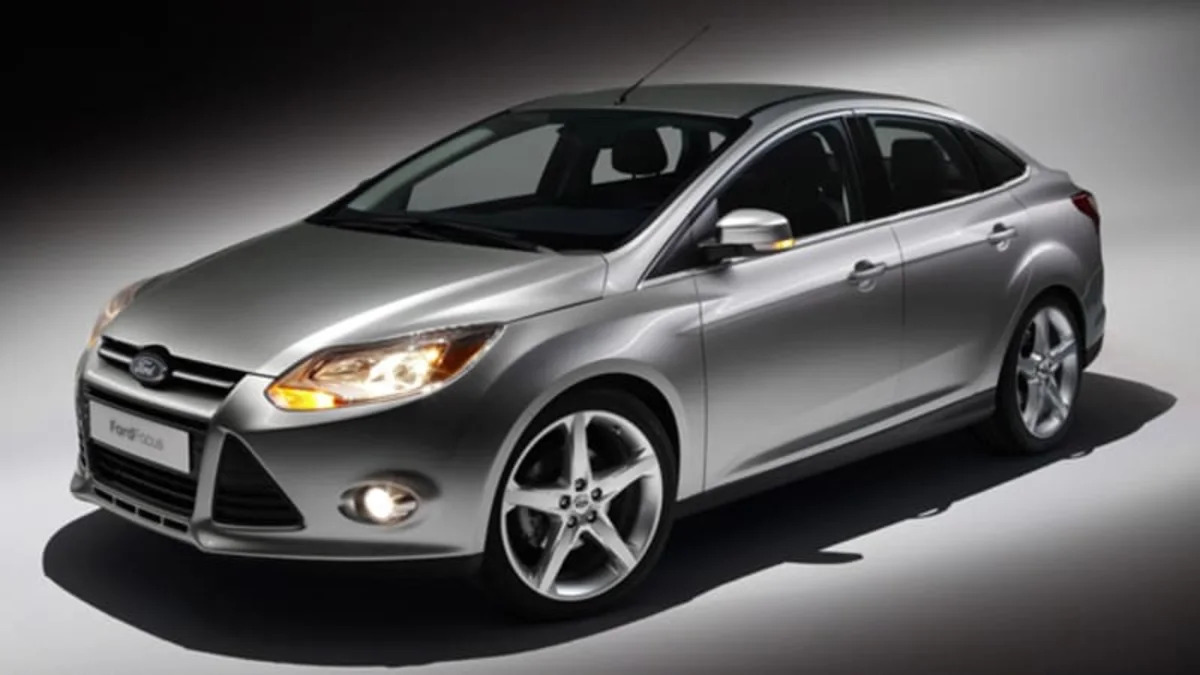
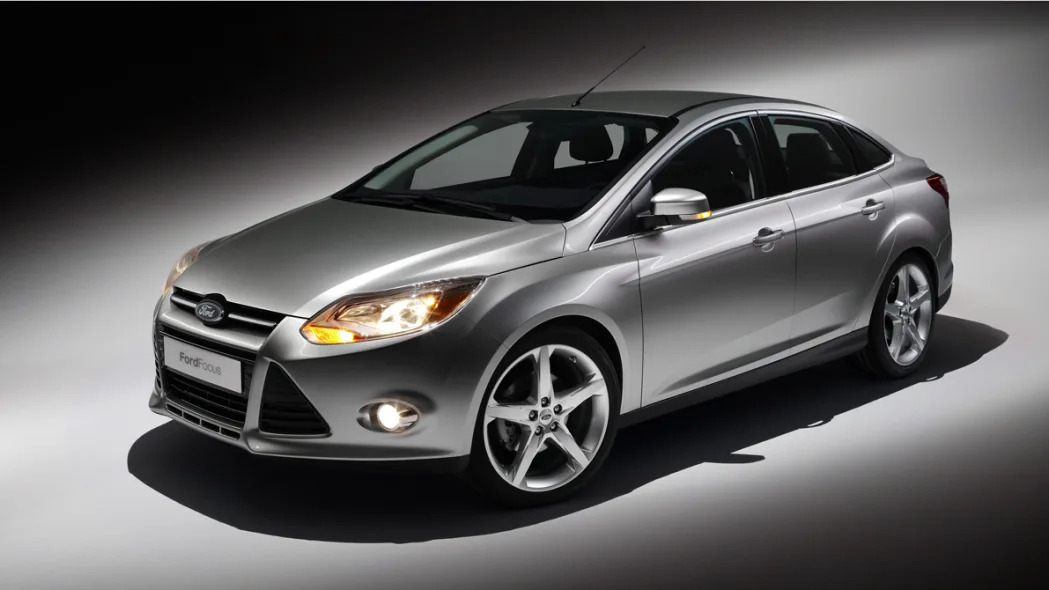

Sign in to post
Please sign in to leave a comment.
Continue